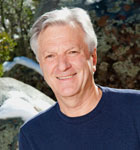
“I have built poured walls with magnesium oxide, and it is dream replacement for portland cement. It sequesters more CO2 than is required to make it, and it’s being made from sea water.” Michael Frerking, Living Systems
Talking with leading-edge architect and builder Michael Frerking conjures up a scene from the 1985 classic film Back to the Future: An eccentric gentleman with a crop of white hair is working in his garage laboratory.
Marty McFly: “Whoa, this is heavy.”
Dr. Emmett Brown: “Weight has nothing to do with it.”
Except in this case we’re in Prescott, Arizona—not the imaginary Hill Valley, USA. And weight actually has a lot to do with it—“it” being not a time machine but the refinement of an age-old practice of mixing earth, sand, lime, fly ash, and water to make a building material.
“I feel this is about Back to the Future,” says Frerking, founder of design-build firm Living Systems and active proponent of a material known as “poured earth.” “The baby has been thrown out with the bathwater. Many family, personal, and business traditions that were worthwhile have been lost in corporate America’s pursuit for short-term profits. Poured earth reintroduces craft, art, and pride back into the construction process. On ‘poured earth day’ everyone from the ready-mix driver to the boom-truck operator knows that their best work is required to create an art and technology that we will all be proud of and will last hundreds of years.”
Getting the Mix Right
Frerking admits that for 25 years he bought into the idea that poured earth wasn’t really a viable option. But well-versed in adobe and rammed earth, he developed a keen eye for soil. “I could look at the soil and tell you [whether] I could use it or not,” Frerking says. Setting up a garage lab, he was determined to prove one way or another the potential of using native soil to make poured earth.
“There are many similarities between poured earth and rammed earth and adobe,” he explains, “[but] getting the right mix takes time. I do small-scale tests for shrinkage and compression until I come up with the right design.” It turned out that persistence was the key. He now performs these tests routinely for his projects. “It takes about a month and a half to get it right,” he says, adding that once he is satisfied with the outcome, he has a geotechnical engineer certify his mix design. “My primary achievement with the poured-earth binders has been to substitute up to 70 percent of the portland cement with synthetic ‘Type F’ fly ash. Type F is considered zero embodied energy as it is a waste-stream product from coal-fired power plants.”
Frerking believes that portland cement, which contributes between five and seven percent of greenhouse-gas emissions, is the real elephant in the room with concrete. “I have built poured walls with magnesium oxide, and it is dream replacement for portland cement. It sequesters more CO2 than is required to make it, and it’s being made from sea water.”
From Architect to Builder to Craftsman
Frerking grew up on a small farm in Pleasant Hill, California, with a strong connection to the land. As a child he watched his Bay Area community get “bladed and graded” into large housing developments. At the age of 12, after discovering the work of Frank Lloyd Wright, Frerking decided to be an architect and do something about suburban sprawl and destruction to the environment. Attending Arizona State University in Tempe, Frerking found himself caught between two worlds. “There were people who were theorists, planning cities of the future, and others with a more practical approach,” Frerking says. “Where the two intersected was where the action was—and where I wanted to be.”
After earning a degree in architecture, Frerking was discomfited by a local design community that he saw as unconcerned with the environment. He traveled and wound up in Prescott, where he found work with a construction crew building homes. “I come from a blue-collar home so it was easy for me to go from architect to builder,” he says.
Frerking was impressed with the knowledge and work ethic of his fellow craftsmen but found what he calls “the space between the trades,” as well as low standards the public seemed willing to accept in the interest of expediency and mass production. “The hierarchy of the trades, where the worker is not recognized for his good work, leads to a lack of pride,” Frerking says. “He may actually be penalized for taking too much time to do it correctly. I feel that today building is not considered by many to be a worthy profession.”
On Steve Jobs and ‘Reality’
Flattening the playing field has been a lifelong pursuit of Frerking’s. So it’s not a surprise that after his poured-earth mix is certified, he works closely with the volume-control worker at the batch plant to portion the mix by weight so that it can be translated into a computer-programmed mix design. Then he meets with volume control, the truck driver, and the boom operator to go over transport time and water usage, writing up the meeting minutes as a quality-control document.
He does the same with his craftsmen, engaging them early in architectural-design-review meetings. The result is a fusion of cutting-edge concepts with practical construction methods.
“The underlying theme and spirit is that everyone wins by creating an environment where innovation and creativity are recognized and results rewarded,” Frerking says. “In the new Steve Jobs book [Steve Jobs by Walter Isaacson], his cohorts called it a ‘reality distortion field,’ which allowed people to achieve the unachievable. I would call it a ‘reality clarification field,’ where the world is built on what can be and is virtually right under our noses rather than convenient assumptions that distort reality.” In other words, the building industry needs to go back to the future.


